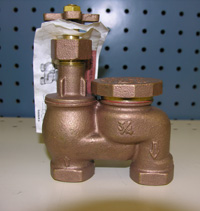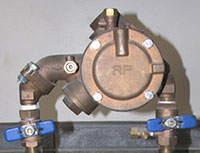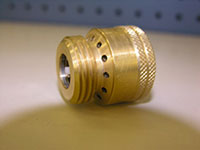by C.Swift and M. Higgins* (6/20)
Revised by Kurt Jones**
Quick Facts….
- Backflow prevention devices must be installed on all sprinkler systems (including sprinklers attached to hoses) using potable (fit for drinking) water.
- Backflow prevention devices are designed to prevent contamination of the potable water system from pesticides, feces and other hazardous materials.
- Hose connection backflow prevention devices may provide protection for the system when insecticides, other pesticides or fertilizers are applied by means of a hose-end spray attachment.
Introduction
Backflow prevention devices protect the drinking water system from contamination due to backflow of non-potable (contaminated) water into the potable (fit for drinking) water supply. Backflow is of two types, back-siphonage and backpressure.
Any drop in pressure in the main city water line can result in back-siphonage backflow of fertilizers, pesticides, manures and other contaminants through sprinkler heads and the irrigation piping system into the potable water supply. This same contamination may occur through a hose-attached sprinkler, spray nozzle or pesticide sprayer. This presents a serious threat to public health. This drop in pressure can result from a break in the line or by lowered mainline pressure due to high water withdrawal, as may occur during fire fighting operations.
Improper installation of a lawn sprinkler pump or injector system may force contaminants back into the potable water supply. In this case, the pressure exerted by the pump is greater than the pressure in the potable water system. This is known as back-pressure backflow.
If properly installed, an approved backflow prevention device will prevent back-siphonage and/or back-pressure backflow. Not all devices are designed to handle both types of backflow.
Backflow prevention devices are designed for installation on sprinkler systems connected to potable (drinking) water supplies only. Sprinkler systems only connected to irrigation water (ditch systems) do not require backflow protection. Some parts of the state of Colorado have dual irrigation systems that apply irrigation and potable water through the same irrigation system. These systems require a reduced pressure principle assembly to protect the domestic water supply.

Figure 1: Atmospheric vacuum breaker. |

Figure 2: Plastic and brass comination AVB units are available. |
 |
The device selected must be the proper device for the degree of hazard and have been approved by the Foundation of Cross Connection Control. Contact your county health, planning or building department for a list of approved devices. These devices must be certified upon installation and at least annually to insure continued backflow prevention. Testing must be done by a contract backflow technician whose backflow certification is current. Contact your community water purveyor for the backflow testing companies and individuals in your area. If your water purveyor does not provide you a list of testers, it is up to you as the water consumer to select one. The Colorado list of contract backflow technicians can be found at http://www.backflow.org/.
Permits normally are required for systems that require backflow prevention devices prior to the installation of a sprinkler system. The installation design, to include the type and placement of backflow prevention devices will be approved during the permit review process. Permits are available from city/county building departments.
Types of Backflow Prevention Devices:
A mechanical backflow prevention device allows water to flow in only one direction. Pressure vacuum breakers (PVB), and the reduced pressure principle device (RP), are the ones commonly used in residential sprinkler systems. The RP device must be used for more hazardous back-pressure situations.
Vacuum Breakers: These are effective only against back-siphonage. These mechanical backflow preventers are not to be used when back-pressure problems may exist. There are two types, the atmospheric vacuum breaker (AVB) and the pressure vacuum breaker (PVB).
The atmospheric vacuum breaker (AVB) is gravity operated and must be installed in a vertical position. The disc float assembly tends to stick in the closed position if under continuous water pressure for long periods of time. It must be installed on the downstream side of all shut-off valves on each sprinkler zone valve. One AVB device is needed in each zone. Check with the water district, planning/building or health department in your county before installing AVBs to ensure they are legal in your area.
Combination AVB and sprinkler valves are available. In these units, a single-valve body combines both a control valve and an atmospheric vacuum breaker. When used, these combination devices must be installed in a vertical position on each zone, with the AVB side downstream of the control side of the unit. This device must always be installed at least six (6) inches (check local codes) above all downstream piping and outlets.
Pressure Devices:
The pressure vacuum breaker (PVB) is designed to open after long periods of continuous water pressure. This type of device may be installed under a constant pressure upstream of all control valves. This device must be installed in a vertical position and at least twelve (12) inches above all downstream piping.

Figure 3: Pressure Vacuum Breaker |

Figure 4: Reduced Pressure Device |

Figure 5: Hose connection vacuum breaker. |
While more expensive than the AVB or combination device, only one PVB is needed for an entire sprinkler system. The PVB is equipped with test cocks and must be tested yearly by a backflow technician.
The reduced pressure (RP) backflow device is the highest level of protection available. This device protects from backflow and back pressure. When installing the device, a minimum of 12 inches of access and clearance between the lowest portion of the device and grade, floor or platform must be provided. There must be adequate clearance around the assembly so that testing and repairs can be accomplished. Reduced pressure backflow devices are often used when pressure vacuum breakers cannot be used (i.e. when downstream piping is higher than the 12 inch clearance mentioned above).
Hose Connections
Sprinkler attachments, spray nozzles and other items attached to a hose connected to the potable water supply must be protected by the use of an approved hose connection vacuum breaker. These devices are designed for hose threaded outlets (sill cocks, hose bibs).
Backflow prevention is critical when using a hose-end sprayer connected to the potable water supply. Backflow can easily suck an insecticide or other chemical back into the domestic water system. A hose connection vacuum breaker should be used as minimum protection when fertilizers, insecticides or other pesticides are applied with a hose-end sprayer.
Additional Notes
Backflow prevention devices are designed with the degree of health hazard in mind. Unless prohibited in your area, lawn sprinkler systems using potable water can be used with either an AVB or PVB device unless a higher degree of hazard exists. The injection of fertilizers, pesticides or other contaminants through the irrigation system represents a higher degree of hazard and requires the use of a device such as the reduced pressure principle backflow assembly (RP device) to ensure safety.
Winterizing Systems
Backflow prevention devices will be damaged by freezing during the winter unless drained of all water. See 4.719, Home Sprinkler Systems: Preparing your Sprinkler System for Winter for details.
Hose connection vacuum breakers are best removed, drained and stored for the winter.
*C.E. Swift, former Colorado State University Extension, Horticulture Agent, Tri River Area. M. Higgins, Grand Junction Pipe and Supply, Grand Junction, Colo. **Kurt Jones, Colorado State University Extension agent, natural resrouces and agriculture, Chaffee County.4/03. Revised 6/20.
Go to top of this page.





